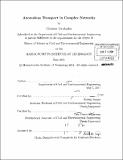Anomalous transport in complex networks
Author(s)
Nicolaides, Christos
DownloadFull printable version (5.367Mb)
Other Contributors
Massachusetts Institute of Technology. Dept. of Civil and Environmental Engineering.
Advisor
Ruben Juanes and Luis Cueto-Felgueroso.
Terms of use
Metadata
Show full item recordAbstract
The emergence of scaling in transport through interconnected systems is a consequence of the topological structure of the network and the physical mechanisms underlying the transport dynamics. We study transport by advection and diffusion in scale-free and Erdős-Rényi networks. Using stochastic particle simulations, we find anomalous (nonlinear) scaling of the mean square displacement with time. We show the connection with existing descriptions of anomalous transport in disordered systems, and explain the mean transport behavior from the coupled nature of particle jump lengths and transition times. Moreover, we study epidemic spreading through the air transportation network with a particle-tracking model that accounts for the spatial distribution of airports, detailed air traffic and realistic (correlated) waitingtime distributions of individual agents. We use empirical data from US air travel to constrain the model parameters and validate the model's predictions of traffic patterns. We formulate a theory that identifies the most influential spreaders from the point of view of early-time spreading behavior. We find that network topology, geography, aggregate traffic and individual mobility patterns are all essential for accurate predictions of spreading.
Description
Thesis (S.M.)--Massachusetts Institute of Technology, Dept. of Civil and Environmental Engineering, 2011. Cataloged from PDF version of thesis. Includes bibliographical references (p. 43-45).
Date issued
2011Department
Massachusetts Institute of Technology. Department of Civil and Environmental EngineeringPublisher
Massachusetts Institute of Technology
Keywords
Civil and Environmental Engineering.